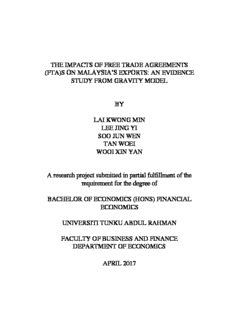
the impacts of free trade agreements (fta) PDF
Preview the impacts of free trade agreements (fta)
THE IMPACTS OF FREE TRADE AGREEMENTS (FTA)S ON MALAYSIA‟S EXPORTS: AN EVIDENCE STUDY FROM GRAVITY MODEL BY LAI KWONG MIN LEE JING YI SOO JUN WEN TAN WOEI WOOI XIN YAN A research project submitted in partial fulfillment of the requirement for the degree of BACHELOR OF ECONOMICS (HONS) FINANCIAL ECONOMICS UNIVERSITI TUNKU ABDUL RAHMAN FACULTY OF BUSINESS AND FINANCE DEPARTMENT OF ECONOMICS APRIL 2017 Copyright @ 2017 ALL RIGHTS RESERVED. No part of this paper may be reproduced, stored in a retrieval system, or transmitted in any form or by any means, graphic, electronic, mechanical, photocopying, recording, scanning, or otherwise, without the prior consent of the authors. ii DECLARATION We hereby declare that: (1) This undergraduate research project is the end result of our own work and that due acknowledgement has been given in the references to ALL sources of information be they printed, electronic, or personal. (2) No portion of this research project has been submitted in support of any application for any other degree or qualification of this or any other university, or other institutes of learning. (3) Equal contribution has been made by each group member in completing the research project. (4) The word count of this research report is _____21006_____. Name of Student: Student ID: Signature: 1. _ LAI KWONG MIN________ _ 1304500______ __________________ 2. _ LEE JING YI_____________ _ 1302951______ __________________ 3. _ SOO JUN WEN___________ _ 1303580______ __________________ 4. _ TAN WOEI______________ _ 1305140______ __________________ 5. _ WOOI XIN YAN_________ _ 1304817______ __________________ Date: _______________________ iii ACKNOWLEDGEMENTS We have spent a lot of time and efforts in performing our skills and knowledges from our studies to complete the research project. Nevertheless, it would not have been possible without the support and help from many individuals. We would like to extend our sincere thanks to all who have directly and indirectly assisted us along the way as we complete this research project. First and foremost, we highly indebted to University Tunku Abdul Rahman (UTAR) for giving us the golden opportunity to carry out this wonderful research on the title of the impact of Free Trade Agreements (FTA)s on Malaysia‟s exports. Next, we would like to express our gratitude to our research supervisor, Dr. Eng Yoke Kee for giving us much attention and time as well as providing insight and expertise that greatly assisted the research. Not only this, she also helped us to overcome the problems throughout the research project and provided us a lot of valuable suggestions. Also, we would like to express our thanks to our coordinator, Ms. Thavamalar a/p Ganapathy, who provided the necessary information regarding the research project. At the same time, we would like to express our thanks to our examiner, Ms Koay Ying Yin and Mr. Foo Chuan Chew, who provided the important suggestions which helps us to improve our research project. Last but not least, our thanks and appreciations also go to our friends and families who provide us with great moral support and encouragement throughout the research period. iv TABLE OF CONTENTS Page Copyright Page……………………………………………………………………….ii Declaration…………………………………………………………………………..iii Acknowledgements…………………………………………………………………..iv Table of Contents……………………………………………………………...…..v-vii List of Tables………………………………………………………………………..viii List of Figures………………………………………………………………………ix List of Abbreviations………………………………………………………….….x-xiii Preface………………………………………………………………………………xiv Abstract…………………………………………………………………………….xv CHAPTER 1 RESEARCH OVERVIEW……………………………………………1 1.0 Introduction……………………………………………...…………….1 1.1 Research Background……………………………………….………1-9 1.2 Problem Statement………………………………………………....9-16 1.3 Research Objectives…………………………………………….…...16 1.3.1 General Objective…………………………...……………16-17 1.3.2 Specific Objectives…………………………………………..17 1.4 Research Questions………………………………………………17-18 1.5 Hypothesis of the Study……………………………………………..18 1.6 Significance of the Study…………………………………………18-20 1.7 Chapter Layout…………………………………………………21-22 1.8 Conclusion…………………………………………………………...22 CHAPTER 2 LITERATURE REVIEW……………………………………………23 2.0 Introduction…………………………………………………………..23 2.1 Empirical Literature Review………………………………...…..23-27 2.2 Conclusion……………………………………………………….…..28 v CHAPTER 3 METHODOLOGY…………………………………………………29 3.0 Introduction…………………………………………………………29 3.1 Theoretical Framework: Gravity Model……………………….…….29 3.1.1 Origins of the Gravity Model ……………………………29-30 3.1.2 Standard Specification of the Gravity Model………….…31-34 3.1.3 Theoretical Foundation of Gravity Model……………..…34-35 3.2 Empirical Framework.………………………………………….……35 3.2.1 Model Specification……………………………………....35-38 3.2.2 Empirical Evidence from Past Researchers and Expected Sign……………………………………………………..38-42 3.3 Hypothesis Development……………………………………………42 3.3.1 Free Trade Agreements..………………………………....42 3.3.2 Other determinants….……………………………………43-44 3.4 Econometric Method……………………………………………44-45 3.4.1 Panel Data Analysis……………………………………....45-46 3.4.2 Panel Unit Root Test…………………………………….46-47 3.4.2.1 Levin, Lin and Chu (LLC) Test……………………….47 3.4.2.2 Augmented Dickey-Fuller (ADF) - Fisher Chi-square Test…………………………………………………47-48 3.4.2.3 Automatic Lag Length Chosen…………………….48-49 3.4.3 Traditional Method of Panel Data Analysis…………………49 3.4.3.1 Pooled Ordinary Least Square (POLS) Model……49-50 3.4.3.2 Fixed Effect Model (FEM)…………………………50-51 3.4.3.3 Random Effects Model (REM)………………………51 3.5 Research Design………………………………………………..51-52 3.6 Data……………………………………………………………..52-54 3.7 Data Collection Methods……………………………………….54-56 CHAPTER 4 DATA ANALYSIS………………………………………………..57 4.0 Introduction………………………………………………………..57 4.1 Descriptive Analysis……………………………………………57-59 4.2 Panel Unit-Root Test……………………………………………59-61 vi 4.3 Panel Data Analysis…………………………………………….61-71 4.4 Conclusion……………………………………………………….71 CHAPTER 5 DISCUSSION, CONCLUSION AND IMPLICATIONS…………72 5.0 Introduction………………………………………………………..72 5.1 Summary…………………………………………………………72-77 5.2 Implications of the Study……………………………………….77-79 5.3 Limitation of the Study and Recommendations for Future Research…………………………………………………………79-80 References……………………………………………………………………….81-87 vii LIST OF TABLES Page Table 1.1: Partner Countries That Involved in Trade Agreement with 6-7 Malaysia Table 3.1: Independent Variables and Expected Sign Included in the 41-42 Gravity Model Table 3.2: List of Countries 53-54 Table 3.3: Sources of Data Set 55-56 Table 4.1: Descriptive Statistic of the Variables Used in Gravity Model 57 Table 4.2: Results of Panel Unit-Root Test 60 Table 4.3: Estimation Results of Gravity Panel Data Model 61-62 Table 4.4: Summary of Findings 64 viii LIST OF FIGURES Page Figure 1.1: Exports of goods and services (current US$) of Malaysia 4 Figure 1.2: GDP at market prices (constant 2010 US$) of Malaysia 10 Figure 1.3: Exports of Goods and Services (% of GDP) of Malaysia 20 ix LIST OF ABBREVIATIONS AANZFTA ASEAN-Australia-New Zealand Free Trade Area ACFTA ASEAN-China Free Trade Agreement ADF Augmented Dickey-Fuller AFTA ASEAN Free Trade Area AIC Akaike Information Criterion AICECA ASEAN-India Comprehensive Economic Cooperation Agreement AJCEP ASEAN-Japan Comprehensive Economic Partnership AKFTA ASEAN-Korea Comprehensive Economic Cooperation Agreement APEC Asia-Pacific Economic Cooperation ARIC Asia Regional Integration Center ARMA Autoregressive-Moving Average Model ASEAN Association of South-East Asian Nations BA Bangkok Agreement BFTA Bilateral Free Trade Agreement BORD Common Border BPLM Breusch-Pagan Lagrange Multiplier BTA Bilateral Trade Agreements CEPII Centre d'Études Prospectives et d'Informations Internationales CES Constant Elasticity Substitution CGE Computable general equilibrium CUSFTA Canada–United States Free Trade Agreement x
Description: